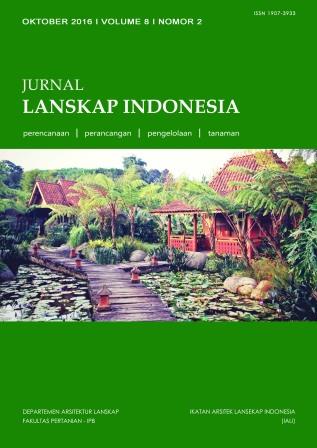KAJIAN KARAKTER PEMBENTUK LANSKAP BUDAYA MASYARAKAT ADAT KAJANG DI SULAWESI SELATAN
Abstract
Kajang is one of the indigenous communities in the Province of South Sulawesi. Kajang cultural landscape formed as a result of interaction between Kajang comunity and their environment. The problems which occurred in this cultural landscape is the degradation of cultural value. The problem caused by the carelessness of youth Kajang about their cultural heritage. The purpose of this study is to identify the landscape elements that formed the landscape character. The method of study was Landscape Character Assessment. The identification of landscape character refered to 11 elements of landscape according to McClelland et al. (1999). Based on the analysis result, the character of Kajang cultural landscape is traditional settlement with the tripatri zoning which depend on local natural resources (forest and agriculture) with the patuntung as their reliance. Landscape unit that shown strong character are sacred settlement area, sacred forest, and the elements around the settlement area such as ancestors tombs, batu temu gelang, balla tammua, and public well.
Downloads
References
Akbar, S. 2014. Komunikasi Pemerintah dan Masyarakat Berbasis Dialek Budaya Lokal (Studi Kasus Proses Komunikasi Penunjang Pembangunan Berbasis Dialek Konjo Pada Masyarakat di Tana Toa Kajang Kabupaten Bulukumba). Jurnal Studi Komunikasi dan Media. 18 (2): 247-257. Jakarta: Kementerian Komunikasi dan Informatika.
Arifin M. 2013. Ruang Hunian dalam Perspektif Komunitas Ammatoa Kajang Sulawesi Selatan. Temu Ilmiah IPLBI. Makassar. 12 - 13 November 2013.
Disnawati. 2013. Penerapan Prinsip Hidup Kamase-Masea Masyarakat Adat Ammatoa Kajang, Bulukumba Sulawesi Selatan dalam Pengelolaan Sumber Daya Alam. Sabda. 8: 3-90. Semarang: Fakultas Ilmu Budaya Universitas Diponegoro.
Erawati, E. 2016. Pola Permukiman Tradisional Kajang. Kapata Arkeologi. 8 (2): 47-162. Maluku: Balai Arkeologi Maluku.
Erawati, E. 2016. Tipe Kawasan Kajang: Dari Ruang Agraris ke Ruang Maritim. Prosiding Seminar Antarbangsa Arkeologi, Sejarah, Budaya, dan Bahas di Alam Melayu Nusantara (ASBAM) V. Makassar. 26 - 27 juli 2016.
Heryati. 2011. Menguak Nilai-Nilai Tradisi pada Rumah Tinggal Masyarakat Ammatoa-Tanatoa Kajang di Sulawesi Selatan. Jurnal Inovasi. 8 (4): 1541-1557. Gorontalo: Universitas Negeri Gorontalo.
Hijjang P. 2005. Pasang dan Kepemimpinan Ammatoa: Memahami Kembali Sistem Kepemimpinan Tradisional Masyarakat Adat dalam Pengelolaan Sumberdaya Hutan di Kajang Sulawesi Selatan. Antropologi Indonesia. 29 (3): 255-268. Jakarta: Fakultas Ilmu Sosial dan Ilmu Politik Universitas Indonesia.
McClelland L, Keller L, Keller G, Melnick R. 1999. Guidelines for evaluating and documentating rural historic landscapes. National Register Bulletin. . [internet]. [diunduh 2015 Februari 10]. Tersedia pada: http://www.nps.gov/history/nr/publications/bulletins/nrb30/.
Palengkahu RA. 1971 Dialek Konjo di Sulawesi Selatan. Ujungpandang: Lembaga Bahasa Nasional.
Sam M, Wikantari R, Yudono A. 2012. Arsitektur Rumah Adat Tradisional Kajang dalam Perspektif Islam. [Skripsi]. Makassar (ID): UIN Alauddin Makassar.
Tudor C. 2014. An Approach to Landscape Character Assessment. England: Natural Engaland.
Wang M, Yu B. 2012. Landscape Characteristic Aesthetic Structure: Construction of Urban Landscape Characteristic Time-Spatial Pattern Based on Aesthetic Subjects. Frontiers of Architectural Research. 1 (3): 305-315.
This journal permits and encourages authors to post items submitted to the journal on personal websites or institutional repositories both prior to and after publication, while providing bibliographic details that credit, if applicable, its publication in this journal. However, after the article is submitted and published in this journal, it is fully copyrighted by the Jurnal Lanskap Indonesia or JLI. If excerpts from other copyrighted works are included, the author must obtain written permission from the copyright owner and give credit to the source in the article. Then, the writer or reader is allowed to copy, share, and redistribute articles/material in any form. But it must still include the appropriate source and credit because the article in this journal is licensed by Creative Commons Attribution 4.0 International License (CC BY 4.0).
I. Proposed Policy for Journals That Offer Open Access
Authors who publish with this journal agree to the following terms:
- Authors retain copyright and grant the journal right of first publication with the work simultaneously licensed under a Creative Commons Attribution License that allows others to share the work with an acknowledgement of the work's authorship and initial publication in this journal.
- Authors are able to enter into separate, additional contractual arrangements for the non-exclusive distribution of the journal's published version of the work (e.g., post it to an institutional repository or publish it in a book), with an acknowledgement of its initial publication in this journal.
- Authors are permitted and encouraged to post their work online (e.g., in institutional repositories or on their website) prior to and during the submission process, as it can lead to productive exchanges, as well as earlier and greater citation of published work (See The Effect of Open Access).
II. Proposed Policy for Journals That Offer Delayed Open Access
Authors who publish with this journal agree to the following terms:
- Authors retain copyright and grant the journal right of first publication, with the work after publication simultaneously licensed under a Creative Commons Attribution License that allows others to share the work with an acknowledgement of the work's authorship and initial publication in this journal.
- Authors are able to enter into separate, additional contractual arrangements for the non-exclusive distribution of the journal's published version of the work (e.g., post it to an institutional repository or publish it in a book), with an acknowledgement of its initial publication in this journal.
- Authors are permitted and encouraged to post their work online (e.g., in institutional repositories or on their website) prior to and during the submission process, as it can lead to productive exchanges, as well as earlier and greater citation of published work (See The Effect of Open Access).



























